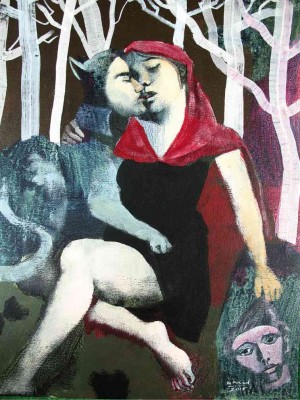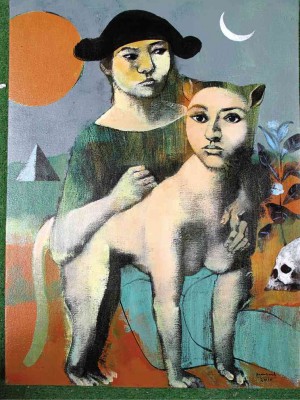
A sheer puzzlement in the unfolding of contemporary Philippine art is the constant inclusion of Marcel Antonio in the roster of Filipino Expressionists, often lassoed in the company of the same generation, the likes of Manny Garibay, Elmer Borlongan and Jeho Bitancor, all heirs to the Expressionism of Ang Kiukok and Onib Olmedo.
Abiding by the definition of Expressionism as “a concept of painting in which traditional adherence to canons of realism and proportion is overridden by the intensity of the artist’s emotions, resulting in distortions of line, shape and color,” Marcel, by the evidence of his works, must seem like a square peg in the round hole of Expressionism.
Indeed, it is the great single achievement of Marcel Antonio to have emerged not from the exaggerated emotional parameters of Expressionism but from a rational coherence of thinking which in fact engendered Existentialism.
It is no surprise that Marcel’s consciousness should impel him by predilection to explore the region of Existentialism, a concept that has always terrified and baffled. Where Expressionism gave vent to the intensities of emotions, Existentialism held emotions at bay, allowing the individual to act on his own, giving rein to his freedom and choice.
The philosopher who gave us the word Existentialism was not its most popular personage, Jean-Paul Sartre, but the theistic philosopher named Gabriel Marcel.

In the arts, Existentialism is exemplified by such iconic works as Van Gogh’s “Night Café,” Edward Munch’s “The Scream,” Giacometti’s “Man Walking,” Francis Bacon’s “Screaming Pope,” Edward Hopper’s “Night Hawks” and Andrew Wyeth’s “Christina’s World.”
Breaking new ground
Marcel Antonio broke new ground in contemporary art when he invested Philippine Expressionism with questions about the universal human condition. By nature inquisitive and questioning, the artist is possessed of interests and curiosities that transgress the limits of the visual arts, exploring the regions of literature and philosophy.
It is this individual quality that sets him apart from his contemporaries. With a rational mind that queries, interpolates and synthesizes observations, raising assumptions that disconcert, disturb and finally discern the essential from the inconsequential, Marcel has prodigiously created an ever-expanding body of works.
Contemporary affliction
His solo exhibition, titled “The Garden of Acedia,” is a continuing revelation of Marcel’s existentialist concerns. A condition both physical and psychological, characterized by sloth, apathy, tedium, boredom, ennui, malaise, detachment, it is easy to construe, is that acedia is a contemporary affliction.
Indeed, it is an ancient somatic and psychological problem that was experienced by the members of the monastic orders, the desert fathers, and ascetics who lived as hermits in extreme solitude and in total detachment from the world. The 16th-century artist Pieter Brueghel once did an engraving where figures sprawled about in a landscape seething with spiritual indolence.

In his own brand of foreboding, Marcel Antonio transports the spirit of acedia into a present-day landscape, emerging from the convergence of allusions and references, creating an armature for a narrative that is half-imagined by the viewer, half-impelled by the artist through his punctilious choice of situations that solicit spatial and psychic discontinuities.
Unsettling theme
The title painting “The Garden of Acedia” is a grand expression of an unsettling theme. Ostensibly, it is the Garden of Gethsemane, where the Lord prayed before the Passion, accompanied by his apostles, who weakly succumbed to the weariness of the day. Is the Lord Himself in the grip of acedia?
But Marcel’s vigorous imagination treats the viewer to a heightened sense of reality with his conflation of Pinoy contemporary realities and characters. Humor and irreverence, sloth and the banalities of diurnal life, the sickening tedium of ceaseless striving: All this connects the audience to a world consumed by listlessness and indifference to the condition of the world.
The other large painting titled “Snake in the Garden” was inspired by a work of fiction authored by the famous American writer Ray Bradbury. Titled “The Playground,” it was described by a critic as “a wonderful little piece of urban horror … it merely deflates the notion of childhood being a fun and happy time.”
The dominant feature in the large canvas is the metal grid work where the children crawl through, clutching at the handlebars, delighted by their precarious balance, as they teeter on the edge. At first glance it is a sight of childhood innocence, but Marcel feigns a spectator’s disregard at the subliminal and imperceptible evil lurking in the place.
It is in the articulation of multiple figures where Marcel displays his unrivalled mastery of composition, cramming an eccentric and configuration within the constraints of a specific space, which, in Marcel’s world, has conceded allegiance to the architectural concreteness of Piero della Francesca and the enigmatic spaces of De Chirico.
From these two exemplars, Marcel has drawn the elegance and drama of geometry that awakens us to constructions where walls open up, windows and doors lead to the unknown, and ceilings and roofs are like fragments of scenery torn from an empty theatrical stage.
Strain of eroticism
A strong strain of eroticism attends many of the works. The sexual resonance is palpable, as if the compulsion to succumb to a viewer’s private obsession.
“Those Who Will Die for Love” has the pulsing rush of reportage such as we read in a tabloid crime of passion, instigated by Marcel’s deliberate execution of figures who bear the weight of a tragic destiny.
A work like “Lovers in the Woods” positively quivers, but in classic Marcel fashion, the artist introduces a disruptive element: a decapitated man’s head clutched by the woman swooning with desire. Is she Judith slaying Holofernes? Is she dancing Salome, rewarded with the head of the Baptist?
The tension is unassailably present, sufficient to stir in the viewer a delectable fear. Marcel redefines horror by bringing us into contact with flesh-and-blood characters, infused with the timeliness of the next morning’s tabloid headline. The artist encloses us within a pictorial space where we are self-immersed and yet too paralyzed to flee.
The woman in the woods, a slave to the pleasures of the flesh, may be the same woman in “A Cuckold Story,” where in a progression into the future, now married to her lover in the woods, she is also a mistress escaping into an assignation with a blond foreigner.
To be sure, Marcel does not merely indulge our libidinous pleasure in voyeurism; he has held his audience captive by our insatiable desire to participate in other people’s lives yet insisting on our apartness and detachment.
The BenCab Museum is along Km. 6, Asin Road, Tuba, Metro Baguio, Philippines. Tel. (+6374)4427165. Mobile: 0920-5301954. E-mail: [email protected]. Website: www.bencabmuseum.org.








































